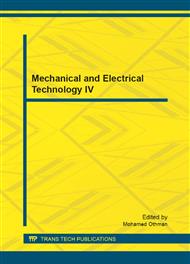[1]
S. Haji, K. Zandi, S. Mohajerzadeh, K. Naeli, and E. A. Soleimani. Micro-machining of.
Google Scholar
[100]
Si using a novel ultra-violet induced anisotropic etching in HNA solution. Microelectronics, ICM Proceedings, 2001: 91-94.
DOI: 10.1109/icm.2001.997495
Google Scholar
[2]
Lim, C.S., Hong, M.H., Kumar, A.S., Rahman, M., and Liu, X.D. Fabrication of concave micro lens array using laser patterning and isotropic etching. International Journal of Machine Tools and Manufacture, 2006, 46 (5): 552-558.
DOI: 10.1016/j.ijmachtools.2005.06.004
Google Scholar
[3]
Borel, S., Arvet, C., Bilde, J., Harrison, S., and Louis, D. Isotropic etching of SiGe alloys with high selectivity to similar materials, Microelectronic Engineering, 2004, 73–74 (0): 301-305.
DOI: 10.1016/s0167-9317(04)00115-7
Google Scholar
[4]
Sato, K., and Shikida, M. 1. 07 - Wet Etching, in Hans, Z. (Ed. ): Comprehensive Microsystems, Elsevier, 2008: 183-215.
DOI: 10.1016/b978-044452190-3.00017-3
Google Scholar
[5]
Henge, A., Acker, J., and Müller, C. Titrimetric determination of silicon dissolved in concentrated HF–HNO3-etching solutions, Talanta, 2006, 68 (3): 581-585.
DOI: 10.1016/j.talanta.2005.04.049
Google Scholar
[6]
Kim, D.W., Lym, S.H., Jung, M.Y., Jeon, H.T., and Choi, S.S. Fabrication of field emission Si-tip array using reduced submicron masks generated by isotropic etching of mask patterns, Microelectronic Engineering, 1999, 46 (1–4): 423-426.
DOI: 10.1016/s0167-9317(99)00124-0
Google Scholar
[7]
Bu, M., Melvin, T., Ensell, G.J., Wilkinson, J.S., and Evans, A.G.R. A new masking technology for deep glass etching and its microfluidic application, Sensors and Actuators A: Physical, 2004, 115: (2–3): 476-482.
DOI: 10.1016/j.sna.2003.12.013
Google Scholar
[8]
Iliescu, C., Miao, J., and Tay, F.E.H. Stress control in masking layers for deep wet micromachining of Pyrex glass, Sensors and Actuators A: Physical, 2005, 117 (2): 286-292.
DOI: 10.1016/j.sna.2004.03.004
Google Scholar
[9]
Yusof, A., Zengerle, R., and Koltay, P. TMMF dry film resist as masking layer in deep etching of Pyrex-glass for microfluidic chip fabrication, Procedia Engineering, 2011, 25 (0): 827-830.
DOI: 10.1016/j.proeng.2011.12.203
Google Scholar
[10]
H. Guodong, A. S. Holmes, and M. E. Heaton. SU8 resist plasma etching and its optimisation. Design, Test, Integration and Packaging of MEMS/MOEMS, 2003: 268-271.
DOI: 10.1109/dtip.2003.1287050
Google Scholar
[11]
Y. Liming, C. Iliescu, F. E. H. Tay et al. SU8 Adhesive Bonding using Contact Imprinting[A]. The Conference of International Semiconductor, 2006, 1: 189-192.
DOI: 10.1109/smicnd.2006.283965
Google Scholar
[12]
MicroChem Corp. Su-8 Permanent Epoxy Negative Photoresist Processing Guidelines. Newton, MA, US: MicroChem Corp, (2006).
Google Scholar


